by Todd Walker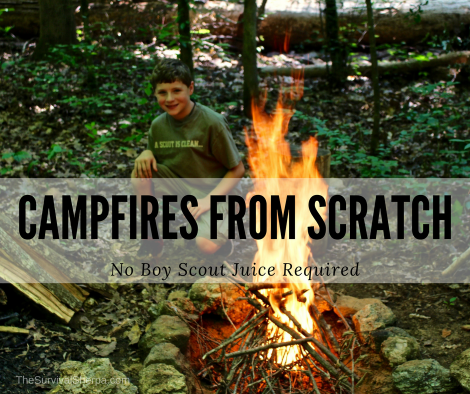
Liar, liar, pants on fire!
I discover at a young age that pouring Boy Scout Juice on sticks for a “quick” campfire was not real smart. Boy Scout Juice is a vague term which includes all sorts of liquid accelerants. We had gasoline at the cabin that day. I can’t remember who to blame for this grand idea, Henry or Craig, but I vividly remember the low whoosh sound that transformed a flickering kitchen match into a flaming mushroom cloud billowing up my legs. Screaming and wild dancing, reminiscent of cartoon characters, commenced in a desperate attempt to extinguish my now flaming trousers.
When the scent of singed hair and screaming finally settled, a silver dollar size blister on my calf taught us all a lesson that day.
Accelerants are dangerous and unnecessary in traditional fire craft. Cheating, some might call it. I’ve often said that there is no such thing as cheating when you really need a fire. Use a road flare if you have one. Camping ain’t an emergency. In modern camps, building a sustainable fire, less the fancy accelerant-impregnated fire starters, seems to be a lost art these days. I find the process of preparing a wooden meal to feed my fires pleasurable, even meditative.
Our irresistible fascination with fire was passed down by early humans who, through observation and notions and necessity, came upon the crazy idea of harnessing the flame. They weren’t content to live out their days cold and wet. This simple, powerful tool warmed hearths, made pottery, fashioned other tools, cooked meals, made potions, dispelled darkness, forged bronze, just as we use it today. The only difference for us moderns is that we route fire through insulated wires. But we’ve lost the aroma of wood smoke in our modern processes. Ah, that wonderful smell!
Many moderns never learned how to build a campfire, not from scratch. We hope this whets your appetite. Gather around our fire ring as we burn a few sticks and embrace the warming gift of fire.
Fire from Scratch
To transition from modern to a traditional fire-starter, you need things. Things like wood and air. These two are the easiest to procure. The third thing, which can be the most difficult to come by, is a heat source hot enough to complete the fire triangle, and, as intended, set stuff alight.
The heat source, modern or traditional, won’t produce a sustainable fire without properly prepared wood. I’ve witnessed, on occasion, fire-starting fails by people using a plumber’s blow torch. Lightening is another option… but you must wait patiently near the chosen tree.
For this exercise in fire-starting, our heat will come in the form of sparks from rocks and metal. Those of the traditional camping style call these materials flint and steel (not to be confused with ferrocerium rods). Sharp rocks are used to scrape micro particles from the steel which oxidizes rapidly into sparks. If you’d like to know the Secret of Flint and Steel, our previous article may help.
Moderns may scoff at flint and steel as a fire maker. Why not use a Bic? It’s your fire. Use whatever ignition method you like. In my experience of teaching and learning fire craft, an open flame offers no distinct advantage until you understand how a fire eats. Practicing traditional methods makes the learner more attentive to the finer details of planning a fire’s menu.
One test for beginner and experienced campers is to start a campfire using a single match. This experiment gives immediate feedback as to how carefully the fire-chef prepared the menu. If the match ignites and consumes your meal, you’ll be ready to practice more traditional methods.
A true primitive Fire from Scratch method requires rubbing sticks together. If you’re interested in twirling up fire, read and practice these articles: Bow drill and hand drill.
Wood Size Matters
The most common failure in feeding a fire is wood size. I’ve used the analogy before of creating a fire meal plan – breakfast, lunch, and dinner. It’s worth repeating… with a bit of a twist.
Don’t cheat on preparing the appetizer for flint and steel ignition. If you’ve ever placed a delicate fire egg (ember) in a tinder bundle (via friction methods), you understand the importance of this starter meal. The same holds true for charred material aglow from flint and steel sparks. A baby ember’s appetite is delicate. If it likes the first offering, it will be stimulated to eat more of your carefully prepared fare.
In many flint and steel demonstrations viewed on computer screens, char cloth is laid on the rock in such a way as to catch a spark flying from the scraped steel. I’ve found that having a larger landing strip for sparks increases the chance of glowifing the charred material. Try sending your sparks into the target-rich char tin. Once you see points of light in the tinder box, place your appetizer on top of the glowified stuff and blow it to flame. Remember to close the lid of your tinder box to starve the glowified embers of oxygen for your next fire.
You can also make your own South African tonteldoos (tinder box) for more flint and steel options.
Appetizer aflame, your fire is ready to ravage the kindling salad above it. Surface-area-to-volume ratio (SAV) plays an important role in the combustion of cellulose. This is a fancy way of describing a particles fineness. The more fineness (higher SAV), the more readily wood will burn. Fine twigs/sticks have low ignition times and burn quickly.
Arrangement
Ever watch a cooking show? Chefs know the importance of plating a meal to be visually appealing. Presentation can cause the guest to be attracted or reject the meal based solely on appearance and arrangement. We eat with our eyes.
Here’s a little good news…
Your arrangement of wood (fire lay) doesn’t have to be pretty to be palatable. Fire eats ugly. More information on four down-n-dirty fire lays can be found here.
When plating your fire’s meal, keep in mind that different arrangements affect how a fire eats.
- Loose fire lays allow more oxygen to flow through the fuel to burn hotter and quickly dry sticks to the point of combustion. Give your fire plenty of elbow-room to eat.
- Arrange too tightly and the fire will be choked to death from lack of oxygen. However, once a coal bed is established, a tight arrangement of larger fuel will provide longer burn times.
Boy Scout Juice Substitute
This stuff doesn’t come in liquid form, but it’s the closest thing in my Georgia woods to an accelerant. Fat Lighter’d, fatwood, lighter wood, lighter knot, etc. is the resin-rich heartwood of many dead pine trees.
Fat Lighter’d Facts
- All natural with no petroleum products
- Won’t catch your pants on fire at ignition like accelerants
- Smoke from fat lighter’d makes a great mosquito repellant in a smudge pot
- The long leaf pine, which was clear-cut to almost extinction, is the best pitch producing pine tree
- The term ‘fatwood’ came about from the wood in pine stumps being “fat” with resin that was highly flammable
- There are between 105 and 125 species classified as resinous pine trees around the world
Not every pine is created equal. In my experience, one tree in the pine family, White Pine (Pinus strobus), makes poor fat lighter’d. I discovered its lackluster lighter’d on a winter trip with my buddy Bill Reese. We set up camp on the scenic Raven Cliff Falls Trail near a fallen White Pine. I figured all pines would offer up that beautiful, flammable fat lighter’d for our initial fire needs. Not so. With much labor, I finally nursed life into our traditional fire.
Know the wood in your woods.
Once you develop a taste for traditional fire-making, you’ll realize Boy Scout Juice is not required for a comforting campfire menu.
Keep Doing the Stuff of Self-Reliance,
Todd
P.S. – You can also keep up with the Stuff we’re Doing on Twitter, Pinterest, Google +, YouTube, Instagram, and Facebook… and over at our Doing the Stuff Network.
P.P.S – If you find value in our blog, Dirt Road Girl and I would appreciate your vote on Top Prepper Sites! You can vote daily by clicking here or on the image below. Check out all the other value-adding sites while you’re there…
Thanks for Sharing the Stuff!
Copyright © by Survival Sherpa: In light of the recent theft of all my content by a pirate site, my sharing policy has changed. I do not permit the re-posting of entire articles from my site without express written consent by me. My content on this site may be shared in digital form (200 words or less) for non-commercial use with a link back (without no-follow attribute) to the original article crediting the author. All photos, drawings, and articles are copyrighted by and the property of Survival Sherpa. You are more than welcome to share our photos and articles on social media for educational purposes as long as you link back to the original article/photo with credit to the author.
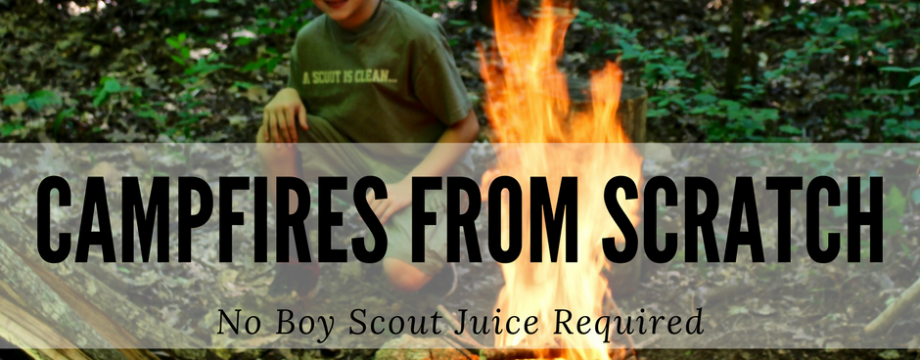
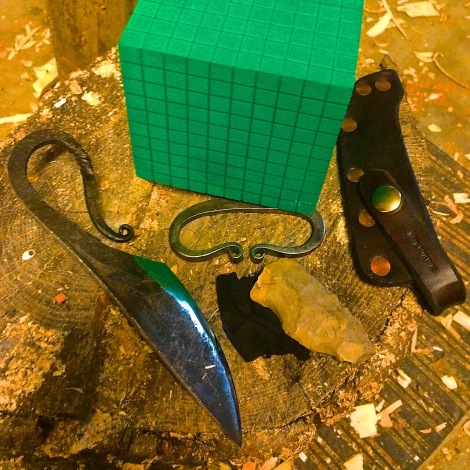
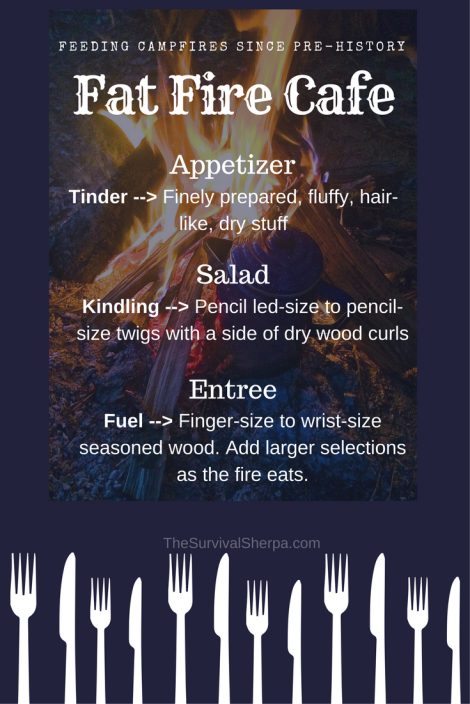

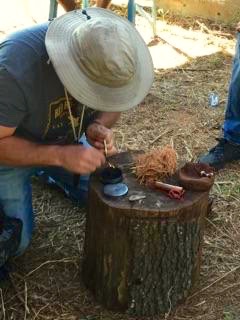
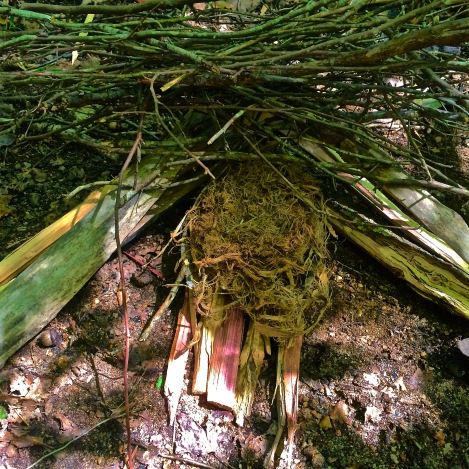








I enjoyed reading your primer on starting a campfire. I had a good lesson the other day trying to light our charcoal grill using the metal “cimney” my dad swore by back in the ’60s. It usually works fine just to use some wadded up dry newspaper under it and not too much charcoal in it to start with, to allow for air flow. I got a little frustrated. Our charcoal is not treated with fire starter fluid. In fact often I start with previously burned briquets that I saved trom totally burning up by cutting off the air to the grill as soon as the food was cooked. I think I used toomuch paper to start with, and even though it had been indoors it may gave been damp. I was having a hard time getting the paper itself to flame, and then when it did the charcoal wasnt catching. The most likely time this will happen is an evening when husband has to leave at a certain time so I cant jst relax and take my time. But I did not want to give up and cook indoors on the stove. Finally I resorted to find materials in the yard cart, and then in the some time bonfire pile, to poke what was flaming better under the charcoal and to work as tinder, then kindling as well. No one witnessed my fervid maneuvers except the dog. I did get the fire going, and the charcoal, but it wasnt very satisfying. Next time I will put in more time prepping, and even consider a real campfire. Our propane fed grill bit the dust last year and we havent replaced it. I enjoy reverting to the old weber, and wouldnt mind relearning more of the old scout tricks – without the scout juice, of course. Thanks for your column sir. Enjoy the fall?
Barbara in Maine
LikeLike
Thanks for reading and sharing your story. You sound a lot like me when grilling. I too shut the vents on my Weber when done cooking to save charcoal for the next fire. I load them in a metal chimney as well along with fresh. At my house, I cheat. I sit my chimney on my propane burner to start the coals, 😉 At the Dam Cabin, I use fat lighter’d with a few kindling sticks. That has worked for me.
Keep Doing the Stuff, Barbara!
P.S. DRG and I are planning a trip to your state this summer. Looking forward to the journey!
LikeLike
I too have found that the white pine is lacking in lighter wood (Maryland). I have found it easier to get the pitch from them and collect that instead.
LikeLike
Excellent presentation.I like how you used a meal plan to illustrate the fire.keep it coming
LikeLike
Pingback: Prep Blog Review: Top Communication Skills For SHTF Survival | Survivopedia
Pingback: Prep Blog Review: Top Communication Skills For SHTF Survival – Welcome to Survival Pal
Pingback: Prep Blog Review: Top Communication Skills For SHTF Survival - Survival Blog
You started with great ideas; communication skills, best “fan” radio list, etc. then jumped knee deep into fire starting. What happened to the radio list and communication methods?
LikeLike
Pingback: Making Fire: The ULTIMATE Guide - Southern Dreams Homestead